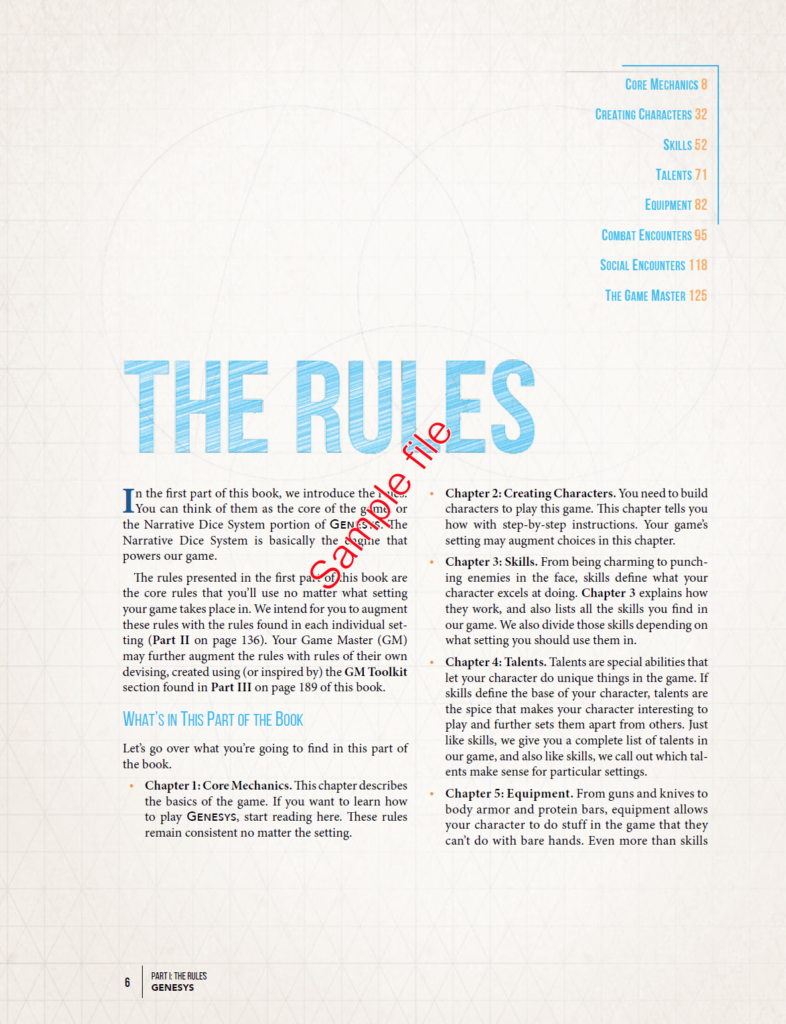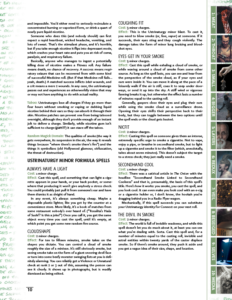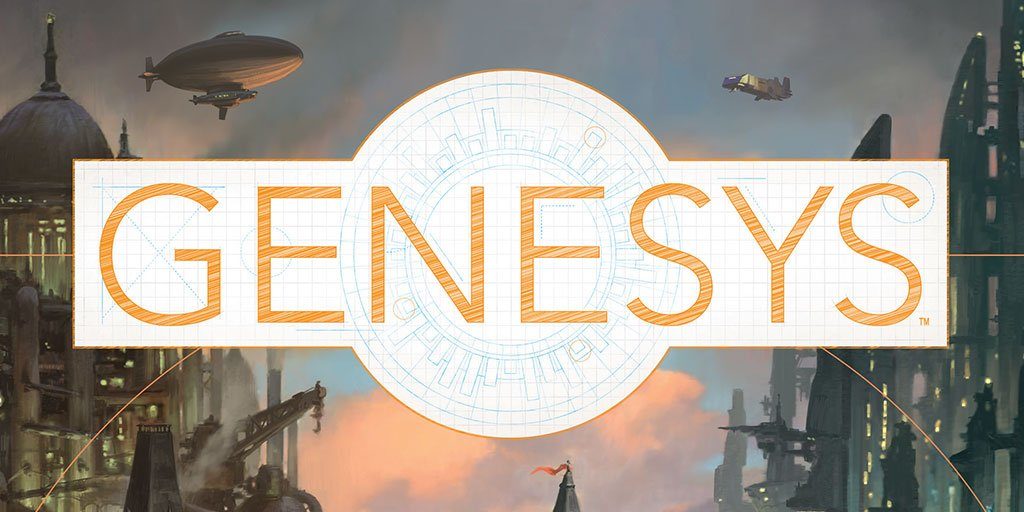Fantasy Flight Games just announced that Genesys, the generic version of the game system that runs their Star Wars and upcoming Legend of the Five Rings roleplaying games, is available as a pdf. I’m interested in that game because I love some of the things it does (I’ve gone on about how the boost and setback dice are some of my favorite dice in rpgs) and one of the example settings is Android, the cyberpunk setting for the Android board game (which I love), the Netrunner game line, and pretty much all of FFG’s near-future cyberpunk games.
But then I noticed it did something really interesting with the cross-references.
 I downloaded the quick preview from DriveThruRPG to check this out. That’s it on the right. There are three parts to the book (“The Rules”, “The Setting”, and “Game Master’s Toolkit”) with each part having different chapters. On the upper-right corner of this page (which is the inside corner of the printed book’s page) is a table of contents for this part of the book. Looking at further pages in the preview, this sub-Table of Contents doesn’t appear at the next chapter.
I downloaded the quick preview from DriveThruRPG to check this out. That’s it on the right. There are three parts to the book (“The Rules”, “The Setting”, and “Game Master’s Toolkit”) with each part having different chapters. On the upper-right corner of this page (which is the inside corner of the printed book’s page) is a table of contents for this part of the book. Looking at further pages in the preview, this sub-Table of Contents doesn’t appear at the next chapter.
This is pretty cool and handy for reference at the game table and really the second rpg I have seen that does this. I first encountered this earlier this year in Tales from the Loop, where each chapter listed the main headings (and some sub-headings) in a chapter-specific table of contents. When I mentioned this back in August, a client remarked, “We may have to steal that in-chapter table of contents thing for upcoming stuff. :)”
It’s a simple thing that I’ve seen in textbooks, but never thought to bring over to layout. I love it. But honestly, Tales from the Loop does it a bit better than Genesys because it gets you to more-specific information easier. In Genesys, this sectional table of contents is only accessible on pages 6, 136, and 189 out of the 256-page book. Tales from the Loop has a new set roughly every twelve pages, is simpler to tell at a glance which chapter you’re on, and is easier to find the start of a new section + section contents with the physical book. It would be easier to find these in Genesys if (a) the section-specific table of contents was on the outside edge of each page and (b) if all three Parts began on the same side of a spread. (Part 3’s start is on the right side of a spread while Parts 1 and 2 are on the left.)
I’ll most likely pitch this concepts to clients in the future. I find it is crazy helpful right there at the table.
As an aside, I’d like to mention Unknown Armies. This book had page references in the margins, similar to earlier roleplaying game books such as Ptolus, Marvel Heroic Roleplaying, and Fate Core System. While not exactly a navigation system like the section-specific table of contents, Unknown Armies (and the others mentioned) worked well for cross-referencing. Downsides in layout involved making sure we have the cross-reference margin note in a place aligned with the related copy and getting the terminology correct in the margin notes as these had to stand on their own.
But what we did when we converted these to pdf, is we reincorporated the margin notes back into the copy because when you’re using a pdf, you can tap directly on a hyperlink, which can be just the copy. This also removed our spacious margin. So your printed version of Unknown Armies reads slightly differently than your electronic version.
“When rolling an identity that has been related to your obsession, you can flip-flop every roll,” reads the printed book. That italicized section referring you to a margin note that reads, “Find out more about these concepts in ‘What Drives You: Passion and Obsession’ on page 9.” The electronic version of the book has that first quoted sentence reading “When rolling an identity that has been related to your obsession (see ‘What Drives You: Passion and Obsession’), you can flip-flop every roll.” In that version, the parenthetical aside was a hyperlink to that “What Drives You” heading.
 We had someone write in, inquiring if the margin reference boxes were forgotten in the pdf.
We had someone write in, inquiring if the margin reference boxes were forgotten in the pdf.
But back to the main topic of navigation, Jeff Tidball wanted the pdf version to have on-page navigation jumps to each chapter. So if you load up a pdf of Unknown Armies, you get something like the image on the right, where the right margin is filled with graphics and text that act as hyperlinks. Tap one and you jump to that chapter.
This stuff takes time to do. You’re not just exporting as a pdf, you’re having to effectively re-layout the book. But the end effect is a navigation system that helps to get the reader to sections they need.
This writing was generously supported by my patrons. You can motivate me to create more writings about layout, game design, and layout in games by becoming a patron. Find out more about my writing goals (plus my secret goal) on this site’s Patreon page.


